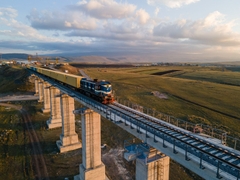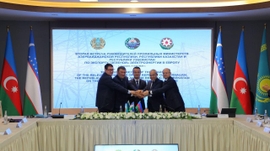With the launch of the largest trade port on the Caspian Sea, Azerbaijan is expected to become a major transit hub for cargo and goods both in the region and throughout Eurasia.
Located in the Alat trade and industrial area and just 43 miles south of Azerbaijan’s capital city, the Baku International Sea Trade Port is currently under construction and is expected to have its first of three phases completed by this year’s end. Once launched, the port will be able to transport up to 15 million tons of cargo and 100,000 containers with the possibility of further expansion of these figures.
“This is a historical project since Azerbaijan is a country that does not have access to the open sea – usually such countries cannot play the role of a transportation center,” President Ilham Aliyev said while addressing a conference on socio-economic development on Monday. Azerbaijan lies along the western shore of the Caspian Sea, which is considered the world’s largest lake since it has no outlet to an ocean, as does the Black and Mediterranean Seas, for example.
“But, despite this, we are turning into a transport hub, covering not only the region but the whole Eurasia.”
Located in the South Caucasus region, south of Russia and near to Turkey, Azerbaijan’s geographical position means it has potential to become a regional transportation hub between east and west. Baku, the capital, stands at the crossroads of major air, sea, rail and land routes within Eurasia, including the Trans-Caspian International Transport Route (TITR), the Baku-Tbilisi-Kars (BTK) railway, and the North-South and East-West trade routes.
While the North-South transport corridor is designed to provide transport communication between the Baltic States and India through Russia and Iran, the East-West route will connect China and Europe through Kazakhstan, Georgia, and Turkey. At the same time, these two routes are expected to intersect in Azerbaijan.
“These corridors connect dozens of countries to each other and create [affordable] conditions for them. Among these countries, Azerbaijan is the only nation that is a member and active participant in both projects,” Aliyev said on Monday.
Meanwhile, the Baku International Sea Trade Port is expected to become a transport hub linking the west, the south, and the north. While the first stone of the port was laid in 2010, earlier this month, a roll-on/roll-off (Ro-Ro) cargo terminal was launched there. This terminal is used to carry wheeled cargo, including automobiles, trucks, semi-trailer trucks, trailers, and railroad cars, which are driven on and off a ship on their own wheels or using a special platform vehicle.
In 2016 Azerbaijan created a free trade zone that covers the entire territory of the Baku International Sea Trade Port. Benefits had by companies located within the zone include a special tax and customs policies.
“In a period of 10 to 20 years, Alat will become Baku’s Jebel Ali,” Taleh Ziyadov, Director-General of Baku International Sea Trade Port predicted in 2016 and referring to the world’s largest free zone in Dubai.
"Currently, there are 10,000 to 12,000 people living in Alat, but thanks to the development of the port and the free trade zone, new workplaces will be created, new houses, schools, and enterprises will be built,” Ziyadov said, according to the report published in Vestikavkaza.
“The new free trade zone will completely change the urban structure of this place. Instead of a small town, we will have a rather significant, modern “satellite city,” which will become the main transport hub of the central part of Eurasia.”







 The Azerbaijani government has rejected the recent claims made by French Interior Minister Gérard Darmanin, who accused Baku of fostering separatis...
The Azerbaijani government has rejected the recent claims made by French Interior Minister Gérard Darmanin, who accused Baku of fostering separatis...
 The Chief of the Atomic Energy Organisation of Iran (AEOI) said that the country has allowed more than 130 inspectors of the International Atomic E...
The Chief of the Atomic Energy Organisation of Iran (AEOI) said that the country has allowed more than 130 inspectors of the International Atomic E...
 Ulviyya Fataliyeva, a female Azerbaijani chess grandmaster, was crowned this week at the European Women’s Chess Championship (EWCC) in Rhodes, Gree...
Ulviyya Fataliyeva, a female Azerbaijani chess grandmaster, was crowned this week at the European Women’s Chess Championship (EWCC) in Rhodes, Gree...



